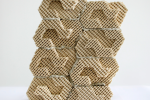Tethon 3D and CONCR3DE target U.S. ceramic AM growth
Nebraska-based ceramic 3D printing specialist Tethon 3D has partnered with CONCR3DE to promote 3D printed ceramics in the United States.Combining Tethon 3Ds expertise in material development and CONCR3DEs binder jetting technology, this alliance aims to enhance strength, precision, and sustainability in ceramic manufacturing.According to the ceramic specialist, CONCR3DEs Armadillo Blue and Elephant Blue 3D printers, designed for technical ceramics like Silicon Carbide, will play a central role, alongside the open-format Armadillo White 3D printer, which supports material research and development.Adding to that, Tethon 3D and CONCR3DE will jointly exhibit novel materials, including Silicon Carbide, Investment Casting, and other technical ceramic formulations, at the 49th International Conference and Expo on Advanced Ceramics and Composites (ICACC 2025) from January 26 31, 2025 in Daytona Beach, Florida.Matteo Baldassari, Co-Founder of CONCR3DE, said, We are thrilled to join forces with Tethon 3D, whose proven track record in developing advanced binder jetting materials makes them the ideal partner for our next-generation additive manufacturing solutions. Tethon 3Ds unwavering commitment to pushing the boundaries of material science, combined with their wealth of experience in binder jetting, perfectly aligns with our vision for elevating the industry standard.CONCR3DEs open-format Armadillo White 3D printer. Image via Tethon 3D.Tethon 3Ds high-performance ceramic powdersEstablished in 2014, Tethon 3D provides novel materials for ceramic 3D printing. As a part of its portfolio, Tethon 3D expanded its proprietary ceramic powder range in 2018, by introducing Tethonite high alumina powder, designed for binder jetting AM. With over 96% alumina content, this material offers enhanced resistance to corrosion, wear, and thermal stress.Building on its original Tethonite stoneware powder released in 2014, the company later added formulations for earthenware and porcelain, and then high alumina.Capable of withstanding temperatures up to 2000C (3632F), the powder supports industrial applications like oil and gas processing, high voltage bushings, and specialty crucibles. When sintered at 1300C (2372F) with Tethon 3Ds liquid binder, it produces porous high alumina structures suitable for technical use.After three years, Boston-based composite 3D printing specialist Fortify partnered with the Nebraska-based specialist to develop technical ceramics for AM. This collaboration saw Fortifys Digital Composite Manufacturing (DCM) technology combine with Tethon 3Ds ceramic expertise to serve diverse industrial and government applications.Leveraging Fortifys FLUX CORE printer and Flux Developer software, the ceramic specialist developed two novel materials, High Purity Alumina (HP-A 99.8) and Low Shrink Aluminum Silicate (LS-AS). Having offered low shrinkage rates, these materials debuted at RAPID + TCT 2021.3D printed ceramic brick. Image via Tethon 3D.Ceramic 3D printing from extreme environments to breakthrough implantsThe use of ceramic 3D printing can be seen in various sectors, with one notable example including 3DCeram Sinto securing a contract from NASAs Marshall Space Flight Center to supply its C1000 FLEXMATIC ceramic 3D printer.Partnering with NASA and Jacobs Space Exploration Group, 3DCeram agreed to 3D print ceramic samples for space durability tests as part of NASAs Materials International Space Station Experiment (MISSE) program. These samples will be attached to the exterior of the International Space Station (ISS) to assess performance in Low Earth Orbit (LEO).At its Grand Ledge facility, 3DCeram is producing 20 parts for launch this year, aiming to evaluate ceramics for spacecraft applications, including heat shields.On the medical front, Kepler University Hospital successfully implanted the first 3D printed ceramic subperiosteal jaw implant, as a part of the EU-funded INKplant project, which involved 19 interdisciplinary partners. Developed by Lithoz and led by Profactor, this implant addresses severe jaw atrophy without requiring invasive bone grafting.Made of biocompatible zirconia using Lithoz Lithography-based Ceramic Manufacturing (LCM) technology, it is fit under the periosteum and reduces recovery time by 75%. Designed collaboratively by Viennas Medical University and others, the implant is set for patenting and mass production by Agensmed.Who won the 20243D Printing Industry Awards?All the news fromFormnext 2024.To stay up to date with the latest 3D printing news, dont forget to subscribe to the 3D Printing Industry newsletter or follow us on Twitter, or like our page on Facebook.While youre here, why not subscribe to our Youtube channel? Featuring discussion, debriefs, video shorts, and webinar replays.Featured image shows a 3D printed ceramic brick. Image via Tethon 3D.


